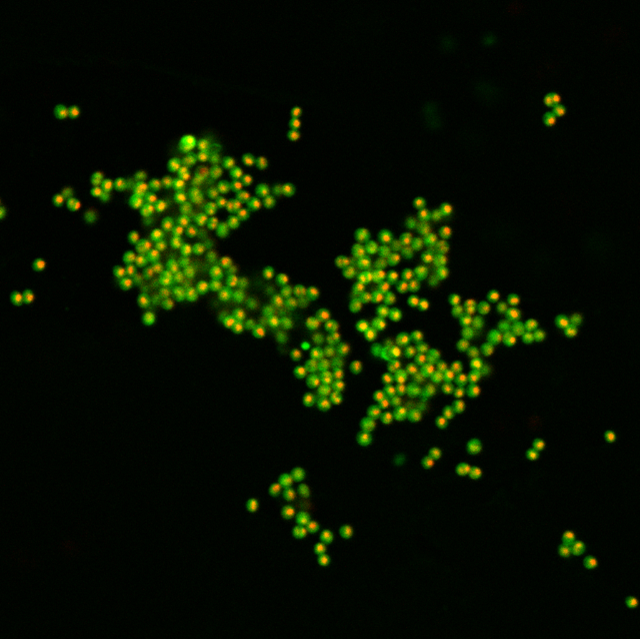Nitrous oxide (N2O) is a very potent greenhouse gas and predicted to be the most important ozone depleting substance of the 21st century. While the contribution of some microbial processes, such as denitrification, to N2O emission is thoroughly characterised, the role of ammonia oxidising microorganisms in N2O production is significantly less understood. The aim of this project is to determine the rates and mechanisms of N2O production by ammonia oxidising microorganisms.
Ammonia oxidising microorganisms play a key role in the global nitrogen cycle and are among the most numerous living organisms on Earth. Their activity results in a significant nitrogen loss from soil ecosystems through production of climate-active gases and leaching of nitrate into rivers and seas. Both ammonia oxidising archaea and bacteria produce N2O, although the quantity and pathways of N2O production vary. In addition to differences between microbial strains, the environmental conditions may also influence the N2O production by ammonia oxidisers, but this topic remains underexplored. Ammonia oxidation involves reactive nitrogen intermediates, and both biotic and abiotic reactions may potentially contribute to their N2O production. Furthermore, ammonia oxidising microorganisms can also indirectly contribute N2O emission by feeding nitrite and nitrate into denitrification. This project will address these major knowledge gaps, and aims to link the microbial ecology and physiology of ammonia oxidisers to N2O emissions.
The project will take advantage of the ammonia oxidising archaea and bacteria routinely cultivated in the lead supervisor’s lab, including the organisms originally discovered by her. Combining the cultivation-based techniques to soil experiments will link the ecology and physiology of the key microorganisms, and nitrogen cycling processes will be studied using state-of-the-art analytical chemistry techniques. This exciting combination will reveal novel insights into nitrogen cycling and greenhouse gas production in the soil environment. The results will inform efforts for predicting and managing nitrogen cycling and may provide potential future options for mitigating climate change.
Figure 1. Soil ammonia oxidising archaeon Nitrosocosmicus franklandus is one of the model organisms for studying N2O production in this project.

This project is not suitable for CASE funding
Each host has a slightly different application process.
Find out how to apply for this studentship.
All applications must include the CENTA application form.
Choose your application route
The PhD student will determine the rates of N2O production in pure cultures of microorganisms and in soil microcosms. The N2O concentrations will be quantified using gas chromatography with μECD detector, and pathways of N2O production will be determined using 15N labelled compounds and isotope ratio-mass spectrometry. The PhD student will gain expertise in growing microorganisms and conducting colorimetric assays for inorganic nitrogen. Microbial ecology will be studied through molecular tools, including qPCR and high-throughput sequencing. To understand the role of environmental factors (including oxygen, substrate concentration and pH), cultures and microcosms will be exposed to contrasting conditions.
DRs will be awarded CENTA Training Credits (CTCs) for participation in CENTA-provided and ‘free choice’ external training. One CTC can be earned per 3 hours training, and DRs must accrue 100 CTCs across the three and a half years of their PhD.
The PhD student will receive advanced research skills training in microbial cultivation, molecular techniques, analytical chemistry, and isotopic analysis. The student will present their research findings in lab meetings, seminars and (inter)national conferences. The student will also be encouraged to take part in transferable skills training and public engagement. Supervisory team has extensive expertise and a complementary skill set in the subject area, and is in an excellent position to support and train the PhD student. This studentship provides a strong scope for developing critical thinking and data interpretation skills, and will equip the successful applicant with a well-rounded skillset.
This project benefits from highly complementary expertise of Lehtovirta-Morley and Mushinski in the area of biogeochemical cycling of nitrogen. Both members of the supervisory team also have ample experience with soil microbiology and soil microcosms. Lehtovirta-Morley is an expert in cultivation, ecology and physiology of ammonia oxidising microorganisms, and Mushinski in analytical chemistry and isotopic analyses of nitrogen.
Year 1: Quantify N2O production in cultures of ammonia oxidising archaea and bacteria. Training in key techniques including GC μECD and IR-MS.
Year 2: Experiments with 15N tracing to understand pathways and mechanisms of N2O production.
Year 3: Soil microcosms to link microbial diversity and abundance to N2O flux. Testing the effect of environmental parameters on N2O production by ammonia oxidising microorganisms.
Bahram, M., Espenberg, M., Pärn, J., Lehtovirta-Morley, L., et al. (2022) ‘Structure and function of the soil microbiome underlying N2O emissions from global wetlands’, Nature Communications 13: 1430. doi: https://doi.org/10.1038/s41467-022-29161-3
Purchase, M.L., Bending, G.D., and Mushinski, R.M. (2023) ‘Spatiotemporal variations of soil reactive nitrogen oxide fluxes across the anthropogenic landscape’, Environmental Science & Technology, 57 (43), pp. 16348-16360. doi: https://doi.org/10.1021/acs.est.3c05849
Schatteman, A., Wright, C., Crombie, A., Murrell, J.C., Lehtovirta-Morley, L.E. (2022) ‘Hydrazines as substrates and inhibitors of the archaeal ammonia oxidation pathway’, Applied and environmental microbiology, 88(8), pp.e02470-21. doi: https://doi.org/10.1128/aem.02470-21
Wright, C.L., Lehtovirta-Morley, L.E. (2023) ‘Nitrification and beyond: metabolic versatility of ammonia oxidising archaea’, The ISME Journal, 17:1358–1368. doi: https://doi.org/10.1038/s41396-023-01467-0
Applicants are strongly encouraged to contact Laura Lehtovirta-Morley ([email protected]) (www.lehtovirta-morleylab.com) to discuss the project and ask any questions they may have.
To apply to this project:
Applications must be submitted by 23:59 GMT on Wednesday 7th January 2026.